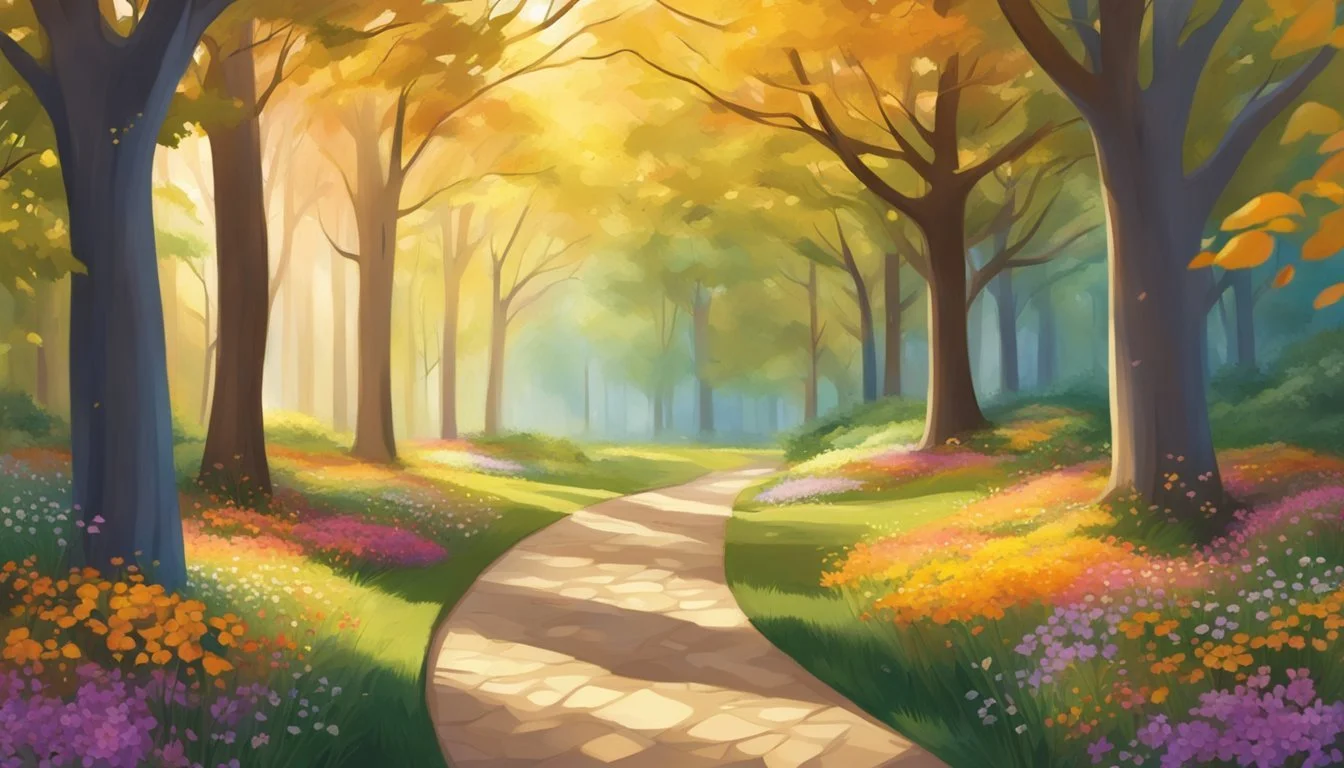10 Unexpected Ways to Find Beauty in Everyday Life
Simple Techniques for a More Appreciative Perspective
Life's beauty often hides in plain sight, waiting to be discovered in the most unexpected places. Our daily routines can blind us to the wonder surrounding us, causing us to overlook extraordinary moments in ordinary circumstances. By shifting our perspective and approaching each day with curiosity, we can uncover hidden beauty in the world around us.
This article explores ten unconventional ways to find beauty in everyday life. From mundane tasks to common objects, these methods encourage a fresh outlook on familiar experiences. Readers will gain insights into transforming their perceptions and appreciating the subtle charm present in daily existence.
1) Photography Walks
Photography walks offer a unique way to discover beauty in everyday surroundings. These leisurely strolls with a camera in hand encourage participants to observe their environment more closely.
During these walks, photographers can focus on capturing ordinary objects from new perspectives. A grocery cart might become an interesting subject when viewed from a low angle or in unique lighting.
Cross-walk signs, often overlooked, can transform into compelling compositions when framed thoughtfully. Photographers might experiment with positioning these signs against interesting backgrounds or capturing them during different times of day.
Ground-level objects like leaves or discarded items can yield surprisingly artistic images. Creating diagonal compositions with these elements adds visual interest to the photographs.
Photography walks also promote mindfulness, as participants must stay present and attentive to their surroundings. This heightened awareness often leads to noticing details that might otherwise go unobserved.
By practicing regularly, photographers develop a keen eye for finding beauty in mundane scenes. This skill extends beyond the walks themselves, enriching daily life with a newfound appreciation for ordinary moments.
2) Children's Laughter
Children's laughter is a powerful source of beauty in everyday life. The sound of a child's genuine giggle can instantly brighten a room and lift spirits.
Laughter from young ones often stems from simple joys, reminding adults to find delight in small moments. A silly face, a playful game, or an unexpected noise can trigger peals of mirth from children.
This innocent expression of happiness is contagious, often causing adults to join in. The shared experience of laughter can strengthen bonds between parents, children, and families.
Children's laughter also serves as a social tool. It helps them connect with peers and adults, fostering relationships and building confidence.
For toddlers, laughter is a way to gain attention and interact with their environment. As children grow, shared jokes become a means of bonding with friends and family members.
The sound of children laughing can evoke feelings of nostalgia in adults, transporting them back to their own carefree childhood days. This connection to youth and innocence adds another layer of beauty to the experience.
3) Street Art
Street art transforms urban landscapes into vibrant canvases, turning everyday spaces into unexpected sources of beauty. Artists use walls, sidewalks, and public structures as their medium, creating colorful murals, thought-provoking installations, and eye-catching designs.
These creative expressions often reflect local culture, social issues, or simply add a splash of color to otherwise dull cityscapes. Street art can range from large-scale murals to small, hidden details that reward observant passersby.
Some street artists incorporate existing elements of the urban environment into their work. They might transform a cracked sidewalk into a whimsical illustration or use a street sign as part of a larger composition.
Street art encourages people to look at their surroundings with fresh eyes. It can turn a routine commute into an impromptu art tour, with new pieces appearing and evolving over time.
By bringing art out of traditional galleries and into public spaces, street art makes beauty accessible to everyone. It adds character to neighborhoods and can spark conversations among community members.
4) A Blooming Flower
A single blooming flower can capture the essence of beauty in everyday life. Its delicate petals unfurl, revealing vibrant colors and intricate patterns that often go unnoticed in our busy lives.
Observing a flower's gradual opening process offers a moment of tranquility. Each stage of growth presents a unique form of loveliness, from tightly closed buds to fully open blossoms.
The flower's scent adds another dimension to its beauty. Fragrant varieties like roses, jasmine, or lilies can transform a space with their natural perfume.
Even common flowers found in yards or along sidewalks can be sources of unexpected beauty. Dandelions, daisies, and wildflowers persist in urban environments, bringing touches of nature to concrete landscapes.
Flowers also symbolize resilience and renewal. They emerge from the earth, endure changing weather, and still manage to display their splendor.
Taking time to appreciate a blooming flower can shift perspective. It serves as a reminder that beauty exists in small, everyday moments for those who pause to notice.
5) A Good Book
A well-crafted book can transport readers to new worlds and open their eyes to beauty in unexpected places. The act of reading itself can be a source of beauty, offering a quiet moment of reflection and imagination.
Books allow readers to experience different perspectives and cultures, revealing the beauty in diverse human experiences. They can shed light on the intricacies of relationships, nature, and the human condition.
The physical aspects of a book can also be beautiful. The feel of paper pages, the smell of ink, and the weight of a hardcover in one's hands all contribute to the sensory experience.
Many books feature stunning illustrations or photographs that capture visual beauty. Even without images, vivid descriptions can paint mental pictures that rival any real-world scene.
Reading can inspire creativity and new ways of thinking, leading to a greater appreciation for the beauty around us. It can provide comfort during difficult times and spark joy in everyday moments.
6) Small Acts of Kindness
Small acts of kindness can bring unexpected beauty to everyday life. These gestures, often simple and spontaneous, have the power to brighten someone's day and create positive ripples in the world.
Offering a genuine compliment to a stranger or friend can lift their spirits and boost their confidence. Paying for the coffee of the person behind you in line creates a moment of surprise and joy.
Helping a neighbor with yard work or shoveling snow demonstrates care for the community. Leaving a kind note for a coworker or family member shows appreciation and thoughtfulness.
Donating unused items to those in need or volunteering at a local charity brings beauty through generosity. Forgiving a debt, whether large or small, can alleviate stress and strengthen relationships.
Sharing supplies with classmates or bringing a small gift for a teacher spreads kindness in educational settings. Showing courtesy to strangers by holding doors or offering a seat on public transport makes the world a little more pleasant.
These small acts of kindness not only benefit the recipients but also enhance the giver's well-being. They create moments of connection and remind us of the beauty inherent in human compassion.
7) Morning Dew
Morning dew offers a fleeting moment of beauty in the early hours. Tiny water droplets cling to grass blades, leaves, and spider webs, creating a sparkling display as the sun rises.
This natural phenomenon transforms ordinary landscapes into magical scenes. The delicate droplets reflect light, turning simple backyard plants into glistening works of art.
Observing morning dew encourages mindfulness and appreciation for nature's subtle wonders. It invites people to slow down and notice the small details that often go unnoticed in daily life.
Photographers often seek out dewy scenes for their ethereal quality. Close-up shots of dew-covered flowers or insects can reveal intricate patterns and textures not visible to the naked eye.
To experience this beauty, one must rise early before the sun's warmth evaporates the droplets. This early morning ritual can become a peaceful way to start the day, connecting with nature's rhythms.
8) Beautiful Handwriting
Handwriting can be a source of unexpected beauty in daily life. Many people find aesthetically pleasing penmanship captivating and soothing to observe.
Skilled writers can transform ordinary text into works of art through their penmanship. Examples range from elegant cursive to stylized print and decorative calligraphy.
Various tools and techniques contribute to beautiful handwriting. High-quality pens, specialty papers, and practiced letter formation all play a role in creating visually appealing script.
Developing attractive handwriting takes time and effort, but can be a rewarding pursuit. Regular practice and attention to detail help improve penmanship over time.
Beautiful handwriting has practical applications beyond aesthetics. Hand-written notes and cards often feel more personal and meaningful than typed messages.
In an increasingly digital world, the art of handwriting provides a tangible connection to tradition and craftsmanship. Many find joy in both creating and appreciating fine penmanship.
9) Old Architecture
Old buildings and structures offer a unique window into the past. Their intricate designs, weathered facades, and historical significance can evoke a sense of wonder and appreciation.
Architectural styles from different eras tell stories of the cultures and societies that created them. Gothic cathedrals, Renaissance palaces, and Art Deco skyscrapers each have their own distinct beauty.
The craftsmanship found in old architecture often surpasses modern construction techniques. Hand-carved stone details, ornate ironwork, and carefully laid brickwork showcase the skill of artisans from bygone eras.
Even in decay, old buildings can possess a haunting beauty. Crumbling walls, faded paint, and overgrown courtyards create an atmosphere of romantic nostalgia.
Exploring old neighborhoods or historic districts can be like stepping back in time. The mix of architectural styles and the patina of age create a visually rich environment.
Preserving and repurposing old buildings helps maintain the character and identity of cities. Adaptive reuse projects breathe new life into historic structures while honoring their original beauty.
10) Shared Smiles
A simple smile exchanged between strangers can brighten an ordinary day. These fleeting moments of connection hold surprising beauty and warmth. Smiles transcend language barriers, creating instant bonds between people from all walks of life.
Sharing a smile with someone on the street or in a store can lift both participants' moods. It's a small act of kindness that costs nothing but can mean everything to someone having a difficult day. The ripple effect of a single smile can spread positivity throughout a community.
Smiling at others also encourages them to smile back, creating a cycle of goodwill. This mutual exchange of positive energy fosters a sense of belonging and shared humanity. It reminds us that we're all in this together, facing life's challenges and joys side by side.
Even behind masks, smiles can be seen in the eyes. Crinkled eye corners and raised cheeks convey warmth and friendliness. Seeking out these subtle expressions of joy adds depth to everyday interactions and helps cultivate a more positive outlook on life.
The Philosophy of Finding Beauty
Finding beauty in everyday life involves cultivating awareness and shifting perspectives. This approach encourages individuals to appreciate the world around them in new and meaningful ways.
Understanding Everyday Moments
Beauty exists in the most ordinary experiences. A warm cup of coffee, the sound of rain, or a child's laughter can hold profound beauty. These moments often go unnoticed in the rush of daily life.
Recognizing beauty requires slowing down and paying attention. It's about seeing the extraordinary in the ordinary. A simple act like watching a sunset or feeling a gentle breeze can become a source of joy and wonder.
The wabi-sabi philosophy from Japan embraces imperfection and impermanence as sources of beauty. This concept encourages people to find value in worn or aged objects, seeing their unique character and history.
The Role of Mindfulness
Mindfulness plays a crucial role in discovering everyday beauty. It involves being fully present and engaged with one's surroundings. This practice helps individuals notice details they might otherwise miss.
Mindful observation can reveal beauty in unexpected places. The intricate patterns on a leaf, the play of light on a building, or the rhythm of city life can all become captivating when viewed with intention.
Regular mindfulness practice enhances one's ability to find beauty. It trains the mind to focus on the present moment, reducing distractions and increasing appreciation for small details. This heightened awareness can transform mundane experiences into moments of awe and gratitude.
Practical Strategies for Everyday Beauty
Finding beauty in daily life requires intentional practices and a shift in perspective. These strategies can help cultivate an appreciation for the ordinary and embrace life's imperfections.
Cultivating Gratitude
Start a gratitude journal to record three beautiful things noticed each day. This practice trains the mind to seek out positivity. Take mindful pauses throughout the day to appreciate small pleasures like a warm cup of coffee or a gentle breeze.
Express appreciation to others regularly. A simple "thank you" can brighten someone's day and foster connections. Share photos of everyday beauty on social media to inspire others and reinforce personal awareness.
Create a beauty board with images, quotes, and mementos that spark joy. Display it prominently as a daily reminder of life's simple pleasures.
Embracing Imperfections
Reframe "flaws" as unique characteristics that add interest and depth. A chipped mug can become a favorite for its distinctive appearance. Wrinkles and scars tell stories of a life well-lived.
Practice the Japanese concept of wabi-sabi, finding beauty in imperfection and impermanence. Appreciate the patina on old furniture or the weathered texture of driftwood.
Engage in activities that celebrate imperfection, like creating purposely asymmetrical art or tending to an wildflower garden. These practices can shift perspective on what constitutes beauty.
Embrace aging as a natural process that brings wisdom and character. Focus on inner beauty and personal growth rather than external ideals.












